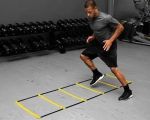The Importance of Flexibility and Mobility Exercises
As a fitness enthusiast, I’ve always focused on strength and endurance in my workouts. But it wasn’t until I began incorporating flexibility and mobility exercises into my routine that I truly started to feel the difference in my overall health and performance. For years, I overlooked these exercises, thinking they were only for people who wanted to improve their yoga poses or dancers stretching before a show. However, after realizing the immense benefits they offer, I now see them as a crucial part of any fitness regimen, regardless of your goals. Flexibility and mobility exercises are vital for maintaining a healthy, functional body, and in this article, I’ll share why they should be an essential part of your daily routine.
What Are Flexibility and Mobility Exercises?
Flexibility and mobility are terms that are often used interchangeably, but they actually refer to slightly different things. Flexibility is the ability of a muscle to lengthen and stretch, while mobility refers to the ability of a joint to move through its full range of motion without discomfort. These two factors work hand-in-hand to improve your body’s overall movement quality. For example, a flexible hamstring allows for better leg extension during a squat, and mobility in the hips allows you to perform deep squats without pain.
Incorporating both flexibility and mobility exercises into my routine has been a game-changer. They not only improve my performance in other workouts but also help me recover more efficiently after intense training. Over time, I’ve noticed improved posture, reduced stiffness, and a decrease in chronic pain that I had grown accustomed to. If you’ve been neglecting these exercises, it’s never too late to start—including them in your workout can yield both short- and long-term benefits for your body.
How Flexibility and Mobility Exercises Enhance Athletic Performance
Whether you’re a casual gym-goer or a professional athlete, improving flexibility and mobility is essential for boosting athletic performance. For me, flexibility and mobility exercises have enhanced my range of motion, allowing me to perform more effectively in activities such as running, weightlifting, and cycling. With better joint mobility, I can move with greater fluidity, which has reduced my risk of injury and increased my ability to perform at my peak.
Take weightlifting, for example. A common issue among weightlifters is restricted mobility in the shoulders, which can limit the range of motion when performing overhead lifts. By incorporating mobility exercises such as shoulder stretches, wall slides, and shoulder dislocations into my routine, I’ve significantly improved my mobility and strength. Flexibility also plays a crucial role in exercises like squats and lunges. Improving the flexibility of my hamstrings, calves, and hip flexors has made these exercises feel more comfortable and efficient, allowing me to progress faster without the fear of injury.
The Role of Flexibility and Mobility in Injury Prevention
One of the main reasons I started focusing more on flexibility and mobility was injury prevention. As I’ve gotten older, I’ve noticed that the aches and pains I once shrugged off have started to become more persistent. These issues often stem from tight muscles or restricted joints that lead to imbalances, which can eventually cause strains, sprains, or other injuries. A lack of flexibility can cause muscles to become overly tight and stiff, while restricted joint mobility can lead to compensations in movement patterns, putting stress on other parts of the body.
Through a regular mobility and flexibility routine, I’ve been able to combat these issues. Stretching and mobility work have helped me lengthen tight muscles, loosen up stiff joints, and correct imbalances. Over time, I’ve noticed a significant reduction in my injuries and faster recovery from workouts. Simple stretches like hamstring and calf stretches, combined with joint mobility drills for the hips and shoulders, have been key in keeping me injury-free. If you’re someone who struggles with regular aches and pains, these exercises can make a world of difference in your comfort level.
The Mental and Emotional Benefits of Flexibility and Mobility Training
Beyond the physical benefits, flexibility and mobility exercises also provide mental and emotional advantages that I’ve found to be just as valuable. When I first started incorporating these exercises, I didn’t expect them to impact my mindset. However, over time, I’ve noticed how stretching and mobility work help calm my mind and reduce stress levels. These exercises often involve deep breathing, which has a meditative effect and allows me to focus on my body’s movements while blocking out distractions.
In addition to reducing stress, I’ve found that flexibility and mobility training can boost my mood and increase my sense of well-being. When I feel more mobile and flexible, I’m more confident in my body and my movements, which improves my overall mental outlook. This connection between body and mind has helped me develop a more positive attitude toward my fitness journey and life in general.
Types of Flexibility and Mobility Exercises to Try
If you’re new to flexibility and mobility exercises, it can be hard to know where to start. Here are a few exercises that I personally recommend for improving both flexibility and mobility:
- Dynamic Stretching: Dynamic stretches, such as leg swings, arm circles, and walking lunges, are excellent for warming up your muscles and preparing your body for activity. These stretches target both flexibility and mobility, helping you move through a full range of motion.
- Foam Rolling: Foam rolling is a form of self-myofascial release that targets tight areas in your muscles, improving flexibility and reducing muscle tension. I use a foam roller regularly to relieve tightness in my quads, hamstrings, and calves, which helps improve my overall mobility.
- Yoga: Yoga is one of the most popular forms of flexibility training, and for good reason. It combines dynamic movements with static stretches to increase flexibility and improve joint mobility. I’ve found that yoga routines focusing on the hips, back, and shoulders have been especially beneficial for me.
- Hip Flexor Stretching: The hip flexors are often tight due to prolonged sitting, and stretching them can dramatically improve both flexibility and mobility. One of my favorite stretches for this area is the lunging hip flexor stretch, which targets the muscles in the front of the hip.
- Joint Mobility Drills: Joint mobility exercises, such as shoulder circles, ankle rolls, and wrist stretches, can improve your range of motion in various parts of the body. These exercises help lubricate your joints and prepare them for movement, which has enhanced my overall joint health.
How Often Should You Incorporate Flexibility and Mobility Exercises?
One of the questions I often hear is, "How often should I do flexibility and mobility exercises?" Based on my experience, I recommend incorporating them into your routine at least 3 to 4 times a week. This can be in the form of a dedicated stretching session or included as part of your warm-up and cool-down. The more consistent you are with your practice, the greater the benefits will be. It’s important to listen to your body—don’t push yourself too hard, and allow time for your muscles and joints to recover between sessions.
Remember, flexibility and mobility exercises are not about achieving perfect flexibility; they’re about improving your functional movement, preventing injuries, and maintaining a healthy body. The key is consistency, patience, and gradual progression. Over time, you’ll see the positive effects on your body, performance, and overall well-being.








